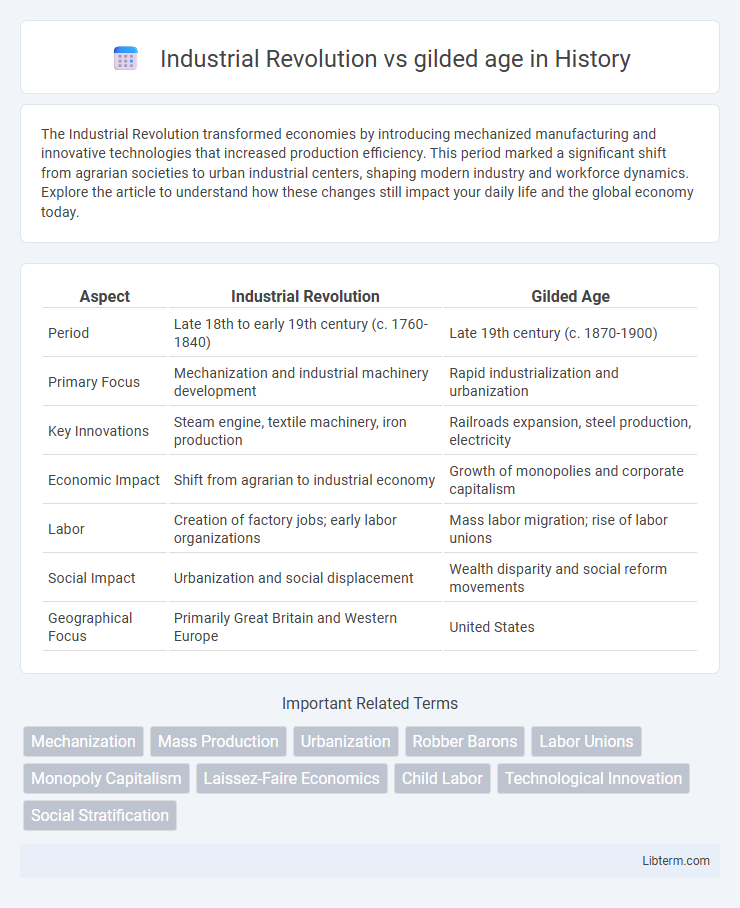The Industrial Revolution transformed economies by introducing mechanized manufacturing and innovative technologies that increased production efficiency. This period marked a significant shift from agrarian societies to urban industrial centers, shaping modern industry and workforce dynamics. Explore the article to understand how these changes still impact your daily life and the global economy today.
Table of Comparison
| Aspect | Industrial Revolution | Gilded Age |
|---|---|---|
| Period | Late 18th to early 19th century (c. 1760-1840) | Late 19th century (c. 1870-1900) |
| Primary Focus | Mechanization and industrial machinery development | Rapid industrialization and urbanization |
| Key Innovations | Steam engine, textile machinery, iron production | Railroads expansion, steel production, electricity |
| Economic Impact | Shift from agrarian to industrial economy | Growth of monopolies and corporate capitalism |
| Labor | Creation of factory jobs; early labor organizations | Mass labor migration; rise of labor unions |
| Social Impact | Urbanization and social displacement | Wealth disparity and social reform movements |
| Geographical Focus | Primarily Great Britain and Western Europe | United States |
Origins of the Industrial Revolution
The Industrial Revolution originated in late 18th-century Britain due to factors such as abundant coal supplies, a stable political climate, and advancements in steam engine technology by inventors like James Watt. The movement led to mass production, urbanization, and significant shifts in labor systems, contrasting with the Gilded Age's emphasis on rapid industrial expansion and wealth accumulation in late 19th-century America. Understanding the roots of the Industrial Revolution highlights economic and technological foundations that later influenced the Gilded Age's industrial and social dynamics.
Defining the Gilded Age
The Gilded Age, spanning from the 1870s to about 1900, was defined by rapid economic growth, industrial expansion, and stark social inequalities in the United States. Marked by the rise of powerful industrialists like Andrew Carnegie and John D. Rockefeller, this era featured significant advancements in steel production, railroads, and oil refining, alongside widespread political corruption and labor unrest. Unlike the broader Industrial Revolution, which focused on mechanization and factory systems, the Gilded Age emphasized wealth accumulation, monopolies, and the complex interplay of capitalism and social change.
Key Innovations and Technological Advances
The Industrial Revolution introduced groundbreaking innovations such as the steam engine, mechanized textile manufacturing, and the Bessemer process for steel production, fundamentally transforming industry and transportation. The Gilded Age accelerated these advancements with the widespread adoption of electricity, the telephone, and the expansion of railroads, enabling large-scale industrial growth and urbanization. Together, these eras laid the foundation for modern technological infrastructure and mass production techniques.
Impact on Urbanization and Cities
The Industrial Revolution accelerated urbanization by driving mass migration to cities for factory work, leading to rapid city expansion and the development of industrial hubs. During the Gilded Age, this urban growth was characterized by significant infrastructure advancements, including skyscrapers and public transit, yet also exposed social challenges like overcrowding and stark economic inequality. The shift from agrarian to industrial economies transformed cities into centers of commerce, manufacturing, and cultural innovation, shaping modern urban landscapes.
Economic Growth and Market Expansion
The Industrial Revolution sparked unprecedented economic growth through mechanization, leading to increased production capacity and the rise of factory-based industries, fundamentally transforming national markets. The Gilded Age further expanded markets by fostering rapid urbanization, infrastructure development such as railroads, and the rise of large-scale corporations, which dominated key sectors like steel, oil, and finance. This period's economic expansion was characterized by wealth concentration and mass consumerism, shaping modern capitalist economies and global trade networks.
Labor Movements and Working Conditions
The Industrial Revolution saw the rise of factories with harsh working conditions, long hours, and minimal safety regulations, leading to the emergence of early labor movements advocating for basic worker rights. The Gilded Age intensified these issues as rapid industrialization and monopolies grew, prompting organized unions like the American Federation of Labor (AFL) to push for better wages, shorter workdays, and improved workplace safety. Strikes such as the Homestead Strike and Pullman Strike highlighted conflicts between labor and industry, underscoring the growing demand for labor reforms during this transformative period.
Social Class Dynamics and Inequality
The Industrial Revolution accelerated urbanization and created a distinct divide between the working class and the emerging industrial capitalist elite, intensifying social stratification. During the Gilded Age, vast wealth accumulated among industrial magnates contrasted sharply with widespread labor exploitation and poverty, exacerbating income inequality and sparking labor movements. Both eras highlighted systemic disparities, but the Gilded Age's ostentatious displays of wealth underscored the profound gap in social mobility and class opportunity.
Political Changes and Reform Efforts
The Industrial Revolution catalyzed significant political changes by accelerating urbanization and labor demands, prompting early labor laws and antitrust legislation during the Gilded Age. During the Gilded Age, political reform efforts focused on curbing corruption through measures like the Pendleton Civil Service Reform Act and addressing growing economic inequalities via regulatory policies. Both eras reshaped American politics with increased government intervention aiming to balance industrial growth and social justice.
Environmental Consequences of Industrialization
The Industrial Revolution and the Gilded Age both triggered significant environmental consequences, including widespread deforestation, air and water pollution, and soil degradation across rapidly urbanizing areas. The surge in coal-powered factories and railroads during the Industrial Revolution resulted in massive carbon emissions and toxic waste, while the Gilded Age's accelerated steel production and mining intensified resource depletion and landscape alteration. Industrialization's lasting environmental impact led to biodiversity loss and contributed to early awareness of human-induced ecological damage.
Lasting Legacy: Industrial Revolution vs Gilded Age
The Industrial Revolution established the foundation for modern manufacturing, urbanization, and technological innovation, fundamentally transforming economies and societies worldwide. The Gilded Age, however, intensified economic disparities and labor conflicts, leading to significant social reform movements and the rise of corporate monopolies. Together, these eras shaped contemporary industrial capitalism and regulatory policies that continue to influence economic and social structures today.
Industrial Revolution Infographic

 libterm.com
libterm.com